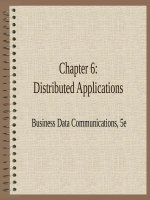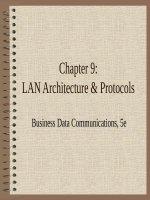Business data communications 5e by stallings chapter 14
Bạn đang xem bản rút gọn của tài liệu. Xem và tải ngay bản đầy đủ của tài liệu tại đây (284.4 KB, 33 trang )
Chapter 14:
Wireless WANs
Business Data Communications, 5e
Reasons for Wireless Networks
• Mobile communication is needed.
• Communication must take place in a terrain that
makes wired communication difficult or impossible.
• A communication system must be deployed quickly.
• Communication facilities must be installed at low
initial cost.
• The same information must be broadcast to many
locations.
Business Data Commun
ications, 5e
2
Problems with Wireless
Networks
• Operates in a less controlled environment,
so is more susceptible to interference,
signal loss, noise, and eavesdropping.
• Generally, wireless facilities have lower
data rates than guided facilities.
• Frequencies can be more easily reused with
guided media than with wireless media.
Business Data Commun
ications, 5e
3
Cellular Wireless Networks
• One of the most revolutionary
developments in telecommunications
• Supports users in locations that are not
easily served by wired networks
• Used for mobile telephones, personal
communications systems, wireless Internet
and wireless Web applications, and more
Business Data Commun
ications, 5e
4
Cellular Network Organization
• Uses multiple low-power transmitters (≤100W)
• Areas divided into cells, each one served by its
own antenna.
• Each cell allocated a band of frequencies, and is
served by a base station
• Adjacent cells are assigned different frequencies
to avoid interference or crosstalk
• Cells sufficiently distant from each other can use
the same frequency band
Business Data Commun
ications, 5e
5
Cellular Geometries
Business Data Commun
ications, 5e
6
Frequency Reuse Patterns
Business Data Commun
ications, 5e
7
Increasing Capacity
• Adding new channels
• Frequency borrowing: Frequencies are taken from
adjacent cells by congested cells
• Cell splitting: Cells in areas of high usage can be split
into smaller cells.
• Cell sectoring: Cell divided into wedge-shaped sectors.
Each sector is assigned a separate subset of the cell's
channels, and directional antennas at the base station are
used to focus on each sector.
• Microcells: Useful in city streets in congested areas,
along highways, and inside large public buildings
Business Data Commun
ications, 5e
8
Cellular System Overview
Business Data Commun
ications, 5e
9
Mobile to Base Channels
• Control channels are used to exchange
information having to do with setting up
and maintaining calls and with establishing
a relationship between a mobile unit and
the nearest BS
• Traffic channels carry a voice or data
connection between users
Business Data Commun
ications, 5e
10
Steps in a Mobile Call
•
•
•
•
•
•
Monitor for strongest signal
Request for connection
Paging
Call accepted
Ongoing call
Handoff
Business Data Commun
ications, 5e
11
Mobile Telephony
• First Generation
– analog voice communication using frequency modulation.
• Second Generation
– digital techniques and time-division multiple access
(TDMA) or code-division multiple access (CDMA)
• Third Generation
– evolving from second-generation wireless systems
– will integrate services into one set of standards.
Business Data Commun
ications, 5e
12
Multiple Access
• Four ways to divide the spectrum among active
users
–
–
–
–
frequency-division multiple access (FDMA)
time-division multiple access (TDMA)
code-division multiple access (CDMA)
space-division multiple access (SDMA)
• FDMA and TDMA discussed in Chapter 17
• CDMA and SDMA discussed here
Business Data Commun
ications, 5e
13
CDMA
• Based on direct sequence spread spectrum
(DSSS)
• Provides immunity from various kinds of noise
and multipath distortion. (The earliest
applications of spread spectrum were military,
where it was used for its immunity to jamming.)
• Can be used for hiding and encrypting signals.
• Several users can independently use the same
(higher) bandwidth with very little interference
Business Data Commun
ications, 5e
14
Cellular
Multiple Access Schemes
Business Data Commun
ications, 5e
15
Third Generation Systems
• Intended to provide provide high speed wireless
communications for multimedia, data, and video
• Reflects trend toward universal personal
telecommunications and communications access
• Personal communications services (PCSs) and
personal communication networks (PCNs) are
objectives for 3G wireless.
• Planned technology is digital using TDMA or
CDMA to provide efficient spectrum use and high
capacity
Business Data Commun
ications, 5e
16
Wireless Application Protocol
(WAP)
• Programming model based on the WWW
Programming Model
• Wireless Markup Language, adhering to XML
• Specification of a small browser suitable for a
mobile, wireless terminal
• A lightweight communications protocol stack
• A framework for wireless telephony applications
(WTAs)
Business Data Commun
ications, 5e
17
WAP Programming Model
Business Data Commun
ications, 5e
18
Wireless Markup Language
• Does not assume a standard keyboard or a mouse;
designed to work with telephone keypads,
styluses, and other input devices common to
mobile, wireless communication
• Documents are subdivided into small, welldefined units of user interaction called cards;
users navigate by moving back and forth between
cards.
• Uses a small set of markup tags appropriate to
telephony-based systems
Business Data Commun
ications, 5e
19
Microbrowser
• Based on a user interface model appropriate for
mobile, wireless devices.
• Traditional 12-key phone keypad is used to enter
alphanumeric characters
• Users navigate among the WML cards using up
and down scroll keys rather than a mouse.
• Navigation features familiar from the Web (e.g.,
Back, Home, and Bookmark) are provided as
well.
Business Data Commun
ications, 5e
20
Wireless Telephony Applications:
A Sample Configuration
Business Data Commun
ications, 5e
21
Satellite Communications
• Two or more stations on or near the earth
communicate via one or more satellites that serve
as relay stations in space
• The antenna systems on or near the earth are
referred to as earth stations
• Transmission from an earth station to the satellite
is an uplink, from the satellite to the earth station
is downlink
• The transponder in the satellite takes an uplink
signal and converts it to a downlink signal
Business Data Commun
ications, 5e
22
Geostationary Satellites
• Circular orbit 35,838 km above
the earth’s surface
• Rotates in the equatorial plane of
the earth at exactly the same
angular speed as the earth
• Remains above the same spot on
the equator as the earth rotates
Business Data Commun
ications, 5e
23
Advantages of
Geostationary Orbits
• Satellite is stationary relative to the earth, so no
frequency changes due to the relative motion of
the satellite and antennas on earth (Doppler effect).
• Tracking of the satellite by its earth stations is
simplified.
• One satellite can communicate with roughly a
fourth of the earth; three satellites separated by
120° cover most of the inhabited portions of the
entire earth excluding only the areas near the north
and south poles
Business Data Commun
ications, 5e
24
Problems with
Geostationary Orbits
• Signal can weaken after traveling that
distance
• Polar regions and the far northern and
southern hemispheres are poorly served
• Even at speed of light, the delay in sending
a signal 35,838 km each way to the
satellite and back is substantial
Business Data Commun
ications, 5e
25









